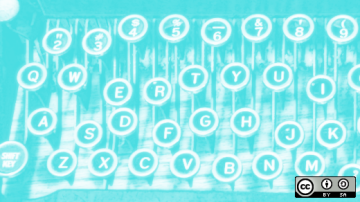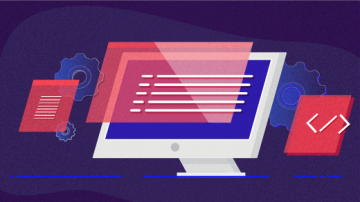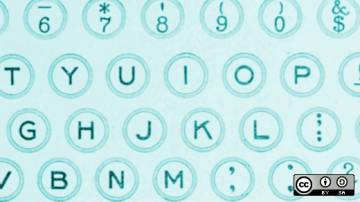One of my favorite stories about Unix is how it turned into a text processing system. Brian Kernighan tells the story in his book Unix: A History and a Memoir (chapter 3) but to summarize: The Unix team at Bell Labs ran the original Unix on a PDP-7 computer, but it was a tiny system and didn't have sufficient resources to support new work. So Ken Thompson and others lobbied to purchase a new PDP-11 computer. Management denied the request. Around the same time, the Patents department planned to buy a new computer platform to produce patent applications using proprietary document formatting software. The Unix group proposed that the Patents department instead buy a new PDP-11 for the Unix team, and the Unix team would create formatting software for them.
That new formatting system was called nroff, short for "New Roff," an updated version of a text formatting program called Roff from a 1960s computer system. The name Roff came from the old expression, "I'll run off a document."
Basic formatting with nroff
By default, nroff collects words and fills paragraphs. When nroff encounters a blank line, it starts a new paragraph. For example, start with this article's introduction, which is only a few paragraphs long:
$ cat intro
Old-school technical writing with groff
Jim Hall
One of my favorite stories about Unix is how it turned
into a text processing system. Brian Kernighan tells the
story in his book Unix: A History and a Memoir (chapter 3)
but to summarize:
The Unix team at Bell Labs ran the original Unix on
a PDP-7 computer, but it was a tiny system and didn't
have sufficient resources to support new work. So Ken
Thompson and others lobbied to purchase a new PDP-11
computer. Management denied the request. Around the same
time, the Patents department planned to buy a new computer
platform to produce patent applications using proprietary
document formatting software. The Unix group proposed
that the Patents department instead buy a new PDP-11 for
the Unix team, and the Unix team would create formatting
software for them.
That new formatting system was called nroff, short for
"New Roff," an updated version of a text formatting program
called Roff from a 1960s computer system. The name Roff
came from the old expression, "I'll run off a document."If you process this file with nroff, lines are "glued" together so the output is paragraphs with full justification. Using nroff also hyphenates words, if that helps balance lines in the text:
$ nroff intro | head
Old‐school technical writing with groff Jim Hall
One of my favorite stories about Unix is how it turned into a
text processing system. Brian Kernighan tells the story in his
book Unix: A History and a Memoir (chapter 3) but to summarize:
The Unix team at Bell Labs ran the original Unix on a PDP‐7 com‐
puter, but it was a tiny system and didn’t have sufficient re‐
sources to support new work. So Ken Thompson and others lobbied
to purchase a new PDP‐11 computer. Management denied the request.
Around the same time, the Patents department planned to buy a newOriginal Unix systems used a typewriter-style printer that used 66 lines of 80 columns on a US Letter page, and nroff makes the same assumptions. It also adds empty lines so each page of output is 66 lines per page, but I've used the head command to show just the first few lines of output because my sample text isn't very long.
Breaking lines and centering text
The first two lines were meant to be separate lines of text. You can insert a formatting instruction to tell nroff to add a line break. All nroff instructions start with a dot, followed by a brief command. To add a line break, use the .br instruction between the first and second line:
Old-school technical writing with groff
.br
Jim HallWhen you process this new file, nroff prints the title and author on separate lines:
$ nroff intro | head
Old‐school technical writing with groff
Jim Hall
One of my favorite stories about Unix is how it turned into a
text processing system. Brian Kernighan tells the story in his
book Unix: A History and a Memoir (chapter 3) but to summarize:
The Unix team at Bell Labs ran the original Unix on a PDP‐7 com‐
puter, but it was a tiny system and didn’t have sufficient re‐
sources to support new work. So Ken Thompson and others lobbied
to purchase a new PDP‐11 computer. Management denied the request.You can add other formatting to make this document look better. To center the top two lines, use the .ce formatting request. This takes a number argument, to indicate how many lines nroff should center. Here, you can center the top two output lines with the .ce 2 request:
.ce 2
Old-school technical writing with groff
.br
Jim HallWith this added instruction, nroff correctly centers the first two lines:
$ nroff intro | head
Old‐school technical writing with groff
Jim Hall
One of my favorite stories about Unix is how it turned into a
text processing system. Brian Kernighan tells the story in his
book Unix: A History and a Memoir (chapter 3) but to summarize:
The Unix team at Bell Labs ran the original Unix on a PDP‐7 com‐
puter, but it was a tiny system and didn’t have sufficient re‐
sources to support new work. So Ken Thompson and others lobbied
to purchase a new PDP‐11 computer. Management denied the request.
Adding page margins
Printing this to a printer results in text starting on the first line of the page, and against the left edge. To add a few lines of extra space from the top of the page, use the .sp request, with the number of blank lines to add:
.sp 5
.ce 2
Old-school technical writing with groff
.br
Jim HallBy default, nroff formats the output so each line is 65 columns wide. Printing to an 80 column US Letter page leaves 15 empty columns. Adding 7 spaces on the left side neatly balances the output with equal left and right page margins. You can create this page offset using the .po 7 request:
.po 7
.sp 5
.ce 2
Old-school technical writing with groff
.br
Jim HallProcessing the new file with nroff produces a plain text page that's ready to print:
$ nroff intro | head
Old‐school technical writing with groff
Jim Hall
One of my favorite stories about Unix is how it turned into a
text processing system. Brian Kernighan tells the story in hisPrinting to a laser printer
Later, the Unix team at Bell Labs acquired a phototypesetting machine, capable of producing printed text similar to a laser printer. To support the typesetter's new capabilities, the Unix team updated nroff to become the typesetter-specific troff program, and a few years later updated it again to become ditroff, the device-independent version of troff.
Linux systems provide modern versions of nroff and troff using the GNU groff program. You can still use the old nroff program name to generate plain text output, or troff to produce ditroffcompatible output. Using the groff program, you can also prepare documents for other kinds of output files, such as Postscript.
You can process the same input file using groffto print on a Postscript-compatible laser printer by selecting a suitable output type using the -T option, such as -Tps to generate a Postscript file. For example, I can print to a printer with the lpr command and the HP_LaserJet_CP1525nw device, because that's how my Linux system recognizes my laser printer:
$ groff -Tps intro | lpr -P "HP_LaserJet_CP1525nw"Generating other kinds of output
If you instead want to save the output as a PDF file, you can convert the Postscript using the ps2pdf tool:
$ groff -Tps intro | ps2pdf - > intro.pdfTo generate a web page from the same file, use -Thtml to set the output type to HTML:
$ groff -Thtml intro > index.htmlThe groff command supports lots of other built-in formatting requests to provide other kinds of document formatting. If you want to learn the other default formatting requests available to you in the GNU groff implementations of nroff and troff, refer to chapter 5 in the The GNU Troff Manual.
Formatting documents using these built-in commands takes a lot of effort to keep everything looking the same. Technical writers who use groff instead use a collection of formatting requests called macros, which provide their own commands to generate section headings, paragraphs, block quotes, footnotes, lists, and other useful document formatting. To learn more about one popular macro package, read How to format academic papers on Linux with groff -me on Opensource.com.













2 Comments